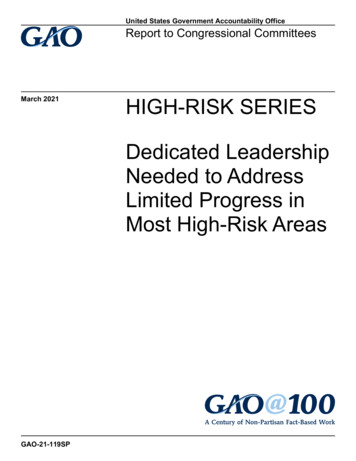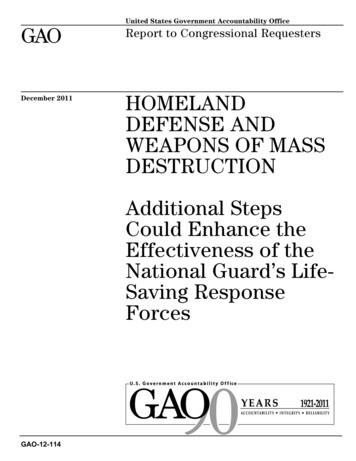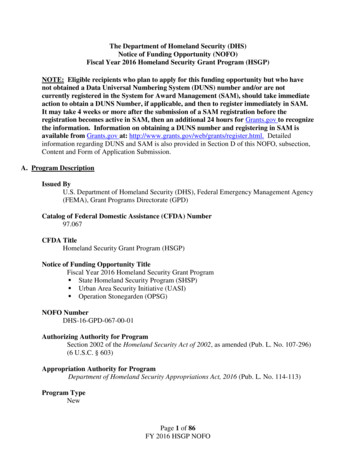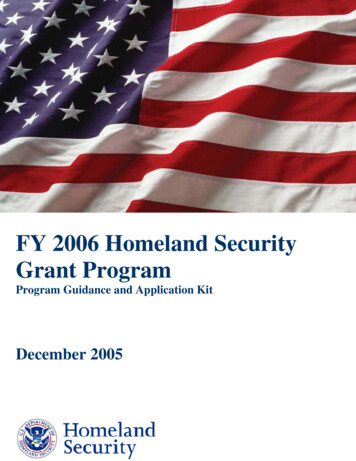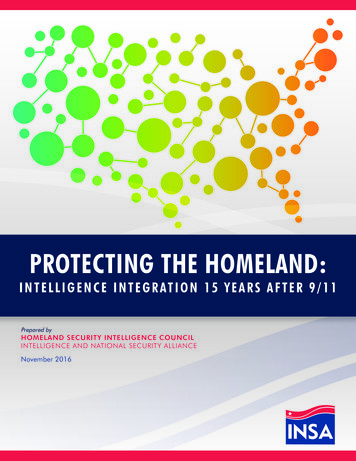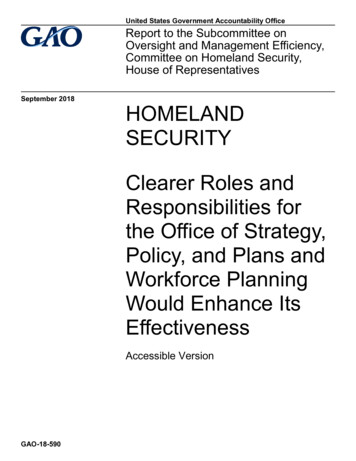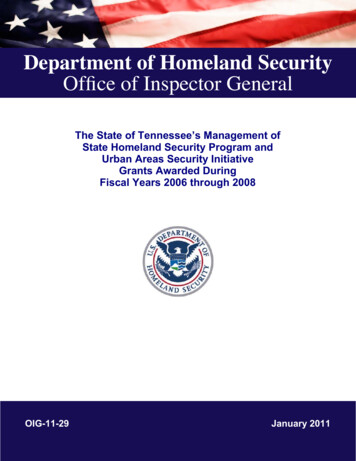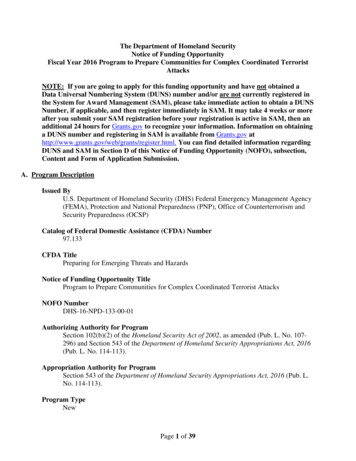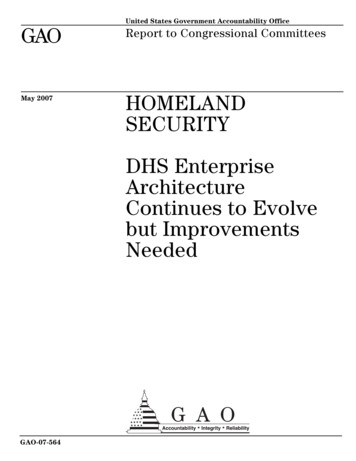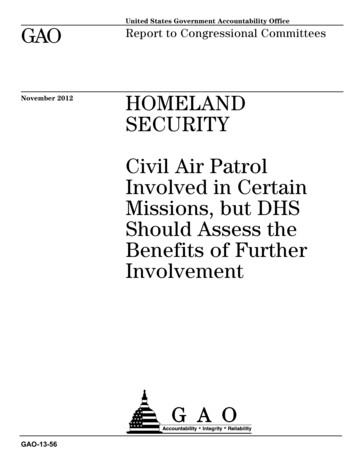
Transcription
GAONovember 2012United States Government Accountability OfficeReport to Congressional CommitteesHOMELANDSECURITYCivil Air PatrolInvolved in CertainMissions, but DHSShould Assess theBenefits of FurtherInvolvementGAO-13-56
November 2012HOMELAND SECURITYHighlights of GAO-13-56, a report tocongressional committeesCivil Air Patrol Involved in Certain Missions, butDHS Should Assess the Benefits of FurtherInvolvementWhy GAO Did This StudyWhat GAO FoundHomeland security partnerships maygrow increasingly important as fiscalconstraints provide impetus for federalagencies to look to partners for missionsupport. One partner is CAP, acongressionally chartered, federallyfunded, nonprofit corporation withapproximately 61,000 volunteermembers that can function as theauxiliary of the U.S. Air Force. CAPconducts missions throughout theUnited States, including counterdrug,disaster relief, and search and rescue,using mostly single-engine aircraft. Theconference report accompanying thefiscal year 2012 DHS appropriationsact directed that GAO study thefunctions and capabilities of CAP tosupport homeland security missions. Inresponse to the mandate, this reportaddresses (1) the extent to which CAPhas been used to perform homelandsecurity missions to date at the local,state, and federal levels, and (2) thefactors that should be considered indetermining CAP’s ability to supportadditional homeland security missionsand the extent to which DHS hasassessed CAP’s capabilities andresources to accomplish suchmissions. GAO reviewed laws andguidance; analyzed fiscal year 2011CAP flight data; and interviewedofficials from DHS, the Air Force, CAP,and a nongeneralizable sample of 10of 52 state-level CAP wings.The Civil Air Patrol (CAP) has performed certain homeland security missions forfederal, state, and local customers, but devotes the majority of its flying hours totraining and youth programs. Several of CAP’s mission areas fit within theDepartment of Homeland Security’s (DHS) definition of homeland security, asfound in the Quadrennial Homeland Security Review Report (QHSR)—a strategicframework for homeland security. For example, CAP disaster assistance and airdefense activities relate to the QHSR mission areas of ensuring resilience todisasters and preventing terrorism and enhancing security, respectively. CAPhas performed some of these activities in support of DHS components, includingthe Federal Emergency Management Agency (FEMA), U.S. Customs and BorderProtection (CBP), and the Coast Guard, as well as state and local governments.For example, CAP has provided disaster imagery to FEMA, performed certainborder reconnaissance for CBP, and assisted the Coast Guard in providing airsupport during the Deepwater Horizon oil spill. CAP has also performedhomeland security-related activities for other customers, such as the U.S. AirForce. For example, 9 of the 10 CAP wings GAO spoke with had participated inmilitary readiness exercises where CAP aircraft provided mock targets for militaryinterceptor aircraft or ground-based radar. CAP’s participation in homelandsecurity activities accounted for approximately 9 percent of its fiscal year 2011flying hours, but the majority of its flying hours (approximately 63 percent) weredevoted to training and flying orientation, with the remaining devoted to otheractivities such as counterdrug and maintenance.What GAO RecommendsGAO recommends that DHS, incoordination with the Air Force, costeffectively assess the extent to whichCAP can further assist DHS with futurehomeland security missions. DHSconcurred with the recommendation.View GAO-13-56. For more information,contact Carol R. Cha at (202) 512-4456 orchac@gao.gov, or Brian J. Lepore at (202)512-4523 or leporeb@gao.gov.Several factors affect CAP’s ability to support homeland security missions, andDHS and its components have not yet assessed how CAP could be used toperform certain homeland security missions. These factors—including legalparameters, mission funding, existing capabilities, and capacity—were issuescited by the DHS components and Air Force and CAP officials GAO contactedthat could affect CAP’s suitability for additional homeland security missions. Forexample, as an Air Force auxiliary, CAP is subject to laws and regulationsgoverning the use of the military in support of law enforcement, which, amongother things, allow CAP to conduct aerial surveillance in certain situations, butpreclude its participation in the interdiction of vehicles, vessels, or aircraft.Similarly, while CAP’s existing operational capabilities—aircraft and vehicles,personnel, and technology—position it well to support certain homeland securitymissions, they also limit its suitability for others. For example, FEMA officialscited the role of CAP imagery in providing useful situational awareness during theinitial stages of some past natural disasters, while, in contrast, officials from CBPand the Coast Guard noted limitations such as inadequate imagery capabilitiesand insufficient detection technology. Although the components we contactedprovided varying opinions regarding CAP’s suitability for certain homelandsecurity activities, DHS has not assessed CAP’s capabilities and resources ordetermined the extent to which CAP could be used to support future homelandsecurity activities. By assessing the ability of CAP to provide additional homelandsecurity capabilities in a budget-constrained environment, DHS in coordinationwith the Air Force could position itself to better understand, and potentially utilize,another resource to accomplish its homeland security missions.United States Government Accountability Office
ContentsLetter1BackgroundCAP Has Performed Certain Homeland Security Missions forFederal, State, and Local CustomersKey Factors Affect CAP’s Ability to Support Homeland SecurityMissions; Assessment of CAP Capabilities and Resources CouldInform Decision-MakingConclusionsRecommendation for Executive ActionAgency Comments, Third-Party Views, and Our Evaluation414242425Appendix IComments from the Department of Homeland Security27Appendix IIComments from the Civil Air Patrol29Appendix IIIGAO Contacts and Staff Acknowledgments31Table 1: CAP Appropriations since Fiscal Year 2007Table 2: CAP Imagery Platforms7209TablesFiguresFigure 1: CAP Cessna 182Figure 2: CAP Fiscal Year 2011 Air Force Auxiliary Flying Hours byType of MissionFigure 3: Examples of Homeland Security Missions Conducted bySelected CAP Wings from Fiscal Years 2007 through 2012Page i61012GAO-13-56 Civil Air Patrol Homeland Security Missions
AbbreviationsCAPCAP-USAFCBPDHSFEMAQHSRCivil Air PatrolCivil Air Patrol-United States Air ForceU.S. Customs and Border ProtectionDepartment of Homeland SecurityFederal Emergency Management AgencyQuadrennial Homeland Security ReviewThis is a work of the U.S. government and is not subject to copyright protection in theUnited States. The published product may be reproduced and distributed in its entiretywithout further permission from GAO. However, because this work may containcopyrighted images or other material, permission from the copyright holder may benecessary if you wish to reproduce this material separately.Page iiGAO-13-56 Civil Air Patrol Homeland Security Missions
United States Government Accountability OfficeWashington, DC 20548November 1, 2012The Honorable Mary LandrieuChairmanThe Honorable Dan CoatsRanking MemberSubcommittee on Homeland SecurityCommittee on AppropriationsUnited States SenateThe Honorable Robert AderholtChairmanThe Honorable David PriceRanking MemberSubcommittee on Homeland SecurityCommittee on AppropriationsHouse of RepresentativesThe events of September 11, 2001, emphasized the concept of homelandsecurity as a shared responsibility across a variety of federal, state, local,and private entities. The Department of Homeland Security (DHS)—in its2010 Quadrennial Homeland Security Review Report (QHSR)—specifiedfive homeland security mission areas: (1) preventing terrorism andenhancing security, (2) securing and managing our borders, (3) enforcingand administering our immigration laws, (4) safeguarding and securingcyberspace, and (5) ensuring resilience to disasters. 1 The QHSR reporthighlights the importance of partnerships among federal, state, local,tribal, territorial, nongovernmental, and private sector entities inaccomplishing these missions, and, more broadly, in ensuring the safetyand security of America and the American population. Such partnershipsmay assume increasing importance as fiscal constraints provide impetusfor federal agencies to look to community partners to provide moresupport for homeland security activities.1DHS, Quadrennial Homeland Security Review Report: A Strategic Framework for aSecure Homeland (Washington, D.C.: February 2010). The Quadrennial HomelandSecurity Review Report outlines a strategic framework for homeland security to guide theactivities of homeland security partners including federal, state, local, and tribalgovernment agencies; the private sector; and nongovernmental organizations. For thepurposes of this report, we have used the five mission areas in the Quadrennial HomelandSecurity Review Report to determine what constitutes a homeland security activity.Page 1GAO-13-56 Civil Air Patrol Homeland Security Missions
The Civil Air Patrol (CAP) is a congressionally chartered, private,nonprofit corporation that functions as an auxiliary to the United States AirForce when providing support to a federal agency. In fiscal year 2012,Congress appropriated approximately 38 million to fund CAP. 2 CAP’smembership includes approximately 61,000 volunteer members spreadacross 52 wings located in the 50 states, the District of Columbia, andPuerto Rico. 3 Using mostly single-engine aircraft, CAP conducts a varietyof missions in support of federal, state, local, and nongovernmentalentities, including search and rescue, counterdrug, disaster relief, airdefense training, and communications support, among others. Theconference report accompanying the DHS appropriations act for fiscalyear 2012 directed GAO to study and report on the functions andcapabilities of CAP to support homeland security missions. 4 In responseto this mandate, this report addresses1) the extent to which CAP has been used to perform certainhomeland security missions to date at the local, state, and federallevels, and2) the factors that should be considered in determining CAP’s abilityto support additional homeland security missions and the extent towhich DHS has assessed CAP’s capabilities and resources toaccomplish such missions.To determine the extent that CAP has been used to perform homelandsecurity missions, we analyzed CAP flight hours to determine the numberand type of homeland security missions conducted by CAP based on thefive homeland security missions outlined by DHS’s QHSR. Specifically,we analyzed flight data from fiscal year 2011, as the most recent full yearof flight data available at the time of our review, and spoke with CAP wingofficials regarding their participation in missions over the last few years todetermine any trends in CAP’s participation in homeland securitymissions for federal, state, and local customers. To assess the reliabilityof these data, we spoke with CAP officials to gain an understanding of the2Pub. L. No. 112-74, § 8022, 125 Stat. 786, 809 (2011).3A wing represents the state-level organization of CAP (including the District of Columbiaand Puerto Rico). A wing is composed of the wing headquarters and all units within itsgeographical boundaries, including individual squadrons.4H.R. Rep. No. 112-331, at 963 (2011) (Conf. Rep.).Page 2GAO-13-56 Civil Air Patrol Homeland Security Missions
processes and databases used to collect and record flight data and tounderstand existing quality control procedures and known limitations. Forthe purposes of our report, we found these data to be sufficiently reliable.We also interviewed officials from DHS and its components, CAPheadquarters, 10 out of 52 CAP wings, and the U.S. Air Force. Weselected the 10 CAP wings based on their involvement in homelandsecurity activities in the National Capital Region, along the border, and indisaster-prone areas. 5 While these interviews are not generalizeable to allCAP wings across the country, they provided a range of perspectivesrelated to CAP operations and homeland security missions. Finally, wealso interviewed officials from the Department of Justice’s DrugEnforcement Administration to discuss CAP’s role in counterdrugoperations as well as their views on CAP’s effectiveness during thesemissions.To determine the factors that should be considered in determining CAP’sability to support additional homeland security missions, and the extent towhich DHS and its components have assessed the capabilities andresources of CAP to accomplish such missions, we reviewed pertinentlaws, regulations, and internal CAP guidance for any restrictions onCAP’s activities, as well as selected mission paperwork and current andpast agreements between CAP and other organizations to identifycommon parameters for CAP operations. In addition, we interviewed CAPand Air Force officials regarding any specific mission approval criteria andfunding requirements, and analyzed flight data to determine any trendsthat might reflect on CAP’s capacity to assume additional missions.Further, we interviewed DHS components regarding their pastexperiences with CAP during homeland security-type operations, theiroverall assessment of CAP’s performance during these operations, andtheir willingness to continue to use CAP for these missions based on pastexperiences. We also interviewed DHS and component officials to identifyany assessments DHS or its components have conducted related toCAP’s role in homeland security. Specifically, we spoke with officials fromDHS’s Office of Policy, U.S. Customs and Border Protection (CBP), theFederal Emergency Management Agency (FEMA), and the Coast Guardto discuss their experiences and relationships with CAP as well as theirviews on expanding CAP’s role in other homeland security missions. We5Specifically, we spoke with officials from the Alabama; Arizona; Florida; Georgia;Maryland; New Mexico; Texas; Virginia; Washington; and Washington, D.C. wings.Page 3GAO-13-56 Civil Air Patrol Homeland Security Missions
also interviewed Air Force and CAP officials and reviewed relevantdocumentation to identify past or ongoing efforts to develop formalagreements between CAP and DHS related to future homeland securityassistance. We compared DHS’s efforts to assess CAP’s capabilities andresources with our past work on effective collaboration and on conductingassessments to determine the extent to which DHS had assessed CAPas a potential homeland security partner. 6We conducted this performance audit from March 2012 throughNovember 2012 in accordance with generally accepted governmentauditing standards. Those standards require that we plan and perform theaudit to obtain sufficient, appropriate evidence to provide a reasonablebasis for our findings and conclusions based on our audit objectives. Webelieve that the evidence obtained provides a reasonable basis for ourfindings and conclusions based on our audit objectives.BackgroundDHS’s MissionIn early 2010, DHS defined its mission and strategy for responding tohomeland security threats. The result of this effort was the completion ofthe QHSR report––a strategic framework to guide the activities ofparticipants in homeland security toward a common goal. One of the keythemes of the QHSR report is the importance of sharing homelandsecurity responsibilities across a variety of actors including federal, state,local, tribal, territorial, nongovernmental, and private sector entities.Emphasizing this shared responsibility, the QHSR report notes that insome areas—such as border security or immigration management—DHSpossesses unique capabilities and responsibilities that are not likely to befound elsewhere. However, in other areas, such as critical infrastructureprotection or emergency management, DHS mainly provides leadershipand stewardship because the capabilities for these areas are often foundat the state and local levels.6See, for example GAO, Catastrophic Disasters: Enhanced Leadership, Capabilities, andAccountability Controls Will Improve the Effectiveness of the Nation’s Preparedness,Response, and Recovery System, GAO-06-618 (Washington, D.C.: Sept. 6, 2006), andResults Oriented Government: Practices That Can Help Enhance and SustainCollaboration among Federal Agencies,GAO-06-15, (Washington, D.C.: Oct. 21, 2005).Page 4GAO-13-56 Civil Air Patrol Homeland Security Missions
History and AdministrativeStructure of CAPIn December 1941, CAP was established out of the desire of civil airmenof the country to be mobilized with their equipment in the commondefense of the Nation. Under the jurisdiction of the Army’s Air Forces,CAP pilots were active during World War II, performing border patrol,search and rescue, and emergency transport, among other missions. In1946, CAP was established as a federally chartered organization. 7 In1948, shortly after the Air Force was established, CAP was designated asthe civilian auxiliary of the Air Force, 8 and later, in October 2000, CAPwas designated as the volunteer civilian auxiliary of the Air Force whenCAP provides services to any department or agency in any branch of thefederal government. 9 CAP has three missions: aerospace education,cadet programs, and emergency services.As a nonprofit organization, CAP has a unique relationship with the AirForce, which may use CAP’s services to fulfill its noncombat programsand missions. The Secretary of the Air Force governs the conduct of CAPwhen it is operating as the auxiliary of the Air Force and prescribesregulations governing the conduct of CAP. CAP is embedded in the AirForce’s command structure under the Air Education and TrainingCommand. 10 The Air Force includes CAP in its internal budget process,provides technical advice to ensure flying safety, ensures that CAP’sfederal funds are used appropriately, and provides building space, amongother things. 11 CAP also has its own administrative structure governed bya volunteer national commander, national vice-commander, and an 11member Board of Governors. A paid chief operating officer managesCAP’s headquarters at Maxwell Air Force Base in Montgomery, Alabama.760 Stat. 346, 347 (1946).862 Stat. 274, 275 (1948).910 U.S.C. § 9442.10The Air Force’s Air Education and Training Command provides basic military training,initial and advanced technical training, flight training, and professional military and degreegranting professional education.11In October 2000 and October 2001, the Air Force and CAP finalized a joint CooperativeAgreement and Statement of Work, respectively. The purpose of the cooperative agreementwas to clarify the relationship by specifying the Air Force’s and CAP’s responsibilities. Thestatement of work specifies certain accountability and management requirements under thecooperative agreement and permits the Air Force to temporarily restrict CAP wings fromreceiving federal funds if the Air Force determines that CAP has inadequate control over itsresources.Page 5GAO-13-56 Civil Air Patrol Homeland Security Missions
However, the chief operating officer has no command authority over thevolunteers and assets spread throughout the United States.Field Organization andResources of CAPCAP is divided into eight geographic regions consisting of 52 state wings(the 50 states, Puerto Rico, and the District of Columbia). Each state wingis divided into smaller squadrons, of which there are approximately 1,500nationwide. CAP has more than 61,000 members divided between cadet(26,725) and adult (34,693) members. 12 According to CAP officials, of theadult members, there are approximately 3,000 active mission pilots. 13Nonpilot adult members contribute to the organization in various ways,serving as crew members, administering wing operations, and managingcadet programs, among other things. CAP has 550 single-engine aircraft,42 gliders, and 960 vehicles. Figure 1 depicts a CAP aircraft.Figure 1: CAP Cessna 18212Cadet programs are for youth ages 12-20. Cadets are educated in four main programareas: leadership, aerospace, fitness, and character development.13A CAP mission pilot is an individual CAP member authorized to fly CAP missions as wellas transport CAP personnel and equipment.Page 6GAO-13-56 Civil Air Patrol Homeland Security Missions
CAP Funding and MissionApproval ProcessThe majority of CAP’s operating budget comes from funds included in theDepartment of Defense’s appropriation and designated by Congress forCAP. CAP is included in the Air Force’s internal budgeting process andsubmits each year a financial plan to the Air Force for consideration.CAP’s financial plan is reviewed and adjusted by both the Air Educationand Training Command and Air Force headquarters. According to an AirForce official involved with CAP’s budget submission, the Air Forceattempts to ensure that CAP receives at least the same amount offunding it had the previous year. However, CAP is competing againstother Air Force priorities in the normal Air Force budget developmentprocess. Still, according to the Air Force official, CAP often receivesadditional funding from Congress above the Air Force’s request. Forexample, in fiscal year 2011, Congress provided an additional 4.2 millionof funding above the Air Force’s request. See table 1 for CAP’sappropriations since fiscal year 2007.Table 1: CAP Appropriations since Fiscal Year 2007(Dollars in millions)Fiscal Year200720082009201020112012Appropriations 36.0 33.7 34.9 33.8 30.4 37.7Source: GAO analysis of U.S. Air Force data.The funds in table 1 are used to reimburse CAP for some Air Forceassigned missions, cover the costs associated with maintenance, andfund aircraft and other procurement, including vehicles. For example,these funds cover mission costs associated with some Air Forceassigned missions, such as air intercept exercises and counterdrugactivities. CAP also receives mission reimbursement from other federal,state, and local agencies. For example, in fiscal year 2011, FEMAreimbursed CAP approximately 155,000 for a variety of disaster-relatedmissions. In addition, CAP receives funding from other sourcesthroughout the course of the year, including state appropriations,membership dues, and member contributions. In fiscal year 2011, CAPreceived approximately 3.2 million in appropriations from 37 states.State funding is sometimes earmarked for a specific state activity, suchas disaster response. CAP also received in fiscal year 2011 3,076,925 inmembership dues.Page 7GAO-13-56 Civil Air Patrol Homeland Security Missions
CAP can conduct missions either as an auxiliary of the Air Force or in itscorporate status. 14 Approximately 75 percent of CAP’s missions areconducted in Air Force auxiliary status. While all missions in support offederal agencies must be conducted in its Air Force auxiliary status, CAPmay conduct missions in its corporate status on behalf of state and localagencies and nongovernmental organizations. CAP pilots are notafforded federal protections when they fly in corporate status. 15All requests for CAP operational missions––with the exception ofcorporate missions and those for Alaska and Hawaii––are coordinatedthrough CAP’s National Operations Center and approved by 1st AirForce. 16 Agencies requesting CAP support contact the CAP NationalOperations Center with a formal request for support. The NationalOperations Center works with the requesting agency and the CAP wing todevelop an operations plan, budget, and funding documents for themission. These are then forwarded to 1st Air Force, which conducts legal,funding, operations, and risk management reviews to ensure that themission meets CAP requirements. Once these reviews are complete, theAir Force can approve the mission and CAP can task its wings with theassignment. CAP corporate missions undergo a similar review process—wherein legal, funding, and risk reviews are conducted—but are notrouted through the Air Force for approval.14Missions flown as the Air Force auxiliary must have a “federal interest.” According to AirForce officials, the definition of “federal interest” was expanded after Hurricane Katrina andcan include such justifications as providing situational awareness to the Air Force,monitoring of state situations by the federal government, or checking on the status of federalbuildings or land.15When flying as members of the Air Force auxiliary, CAP pilots are covered by certainfederal protections, such as the Federal Employees Compensation Act. See 5 U.S.C.§ 8141.16These missions are flown under the authority of U.S. Northern Command, the jointcommand responsible for the continental United States. CAP receives taskings from theair component of Northern Command, 1st Air Force, located at Tyndall Air Force Base,Florida. Missions in Alaska and Hawaii follow the same process, but are approved by 11thAir Force (Alaska) or 13th Air Force (Hawaii).Page 8GAO-13-56 Civil Air Patrol Homeland Security Missions
CAP Has PerformedCertain HomelandSecurity Missions forFederal, State, andLocal CustomersOur review of fiscal year 2011 CAP flight hour data and discussions withofficials from 10 CAP wings show that CAP has performed missions thatfit within three of the five QHSR homeland security mission areas: (1)preventing terrorism and enhancing security, (2) securing and managingborders, and (3) disaster response. 17 CAP missions related to theseareas have accounted for 9 percent of CAP’s flying hours; however, CAPhas devoted the majority of its flying hours (approximately 63 percent) totraining for these and other missions and cadet and Reserve OfficerTraining Corps flying orientations. The remaining 28 percent of CAP’smissions consisted chiefly of assistance to law enforcement for domesticdrug interdiction activities, such as marijuana crop identification, andmaintenance-related flights.Air Force AuxiliaryMissions Include SomeHomeland SecurityActivities, but ConsistPrimarily of Training andFlight OrientationCAP flight hour data for fiscal year 2011 show that CAP participated in avariety of homeland security activities, but that a majority of theorganization’s Air Force-assigned flying time was devoted to training andflying orientation for cadets and Reserve Officer Training Corps members.Specifically, CAP devoted about 63 percent (46,132 hours) of its total AirForce-assigned mission flying hours to training and flying orientations. 18Of the remaining 37 percent of Air Force-assigned flight hours, 9 percent(6,575 hours) were dedicated to homeland security-related missions. Forexample, CAP reported 2,583 Air Force-assigned hours devoted to airdefense, which includes CAP’s participation in the Department ofDefense’s low-flying aircraft readiness exercises and exercises fortraining military pilots to intercept low-flying aircraft. These missions relateto the homeland security mission area of preventing terrorism andenhancing security. CAP also devoted 2,314 Air Force-assigned flighthours to defense support to civilian authorities/disaster relief,corresponding to the homeland security mission area of ensuring17The other two homeland security categories are enforcing and administering ourimmigration laws and safeguarding and securing cyberspace.18Training includes flights to train CAP personnel in conducting operational missions.Orientation flights for CAP cadets and Reserve Officer Training Corps members includethose in both powered and glider aircraft.Page 9GAO-13-56 Civil Air Patrol Homeland Security Missions
resilience to disasters. Figure 2 provides a breakdown of CAP fiscal year2011 flight hours by mission. 19Figure 2: CAP Fiscal Year 2011 Air Force Auxiliary Flying Hours by Type of MissionNotes: Maintenance includes flights in support of aircraft delivery and pickup.For Surrogate Predator training, CAP employs modified aircraft to carry special full-motion in-flightvideo equipment that is used to help train U.S. military ground personnel in remotely piloted aircraftoperations before they deploy overseas.Other homeland security missions includes flights CAP performed for federal, state, and local entitiessuch as escorting naval vessels and reconnaissance flights related to safety planning (e.g.,determining potential evacuation routes) for various events.Some CAP drug interdiction missions, such as certain border reconnaissance, may relate to theQHSR homeland security mission areas of terrorism prevention and border security. However, mostof CAP’s drug interdiction missions support inland crop detection efforts and are therefore presentedseparately in the figure from the homeland security–related missions.CAP headquarters and officials from all 10 CAP wings we spoke withgenerally concurred that the fiscal year 2011 flight hours are reflective oftheir activities in recent years—that is, training and cadet activities haveaccounted for the majority of their missions. CAP intends for its training19CAP reported a total of 102,565 total flying hours for fiscal year 2011. Of this amount,73,435 hours—or 72 percent—were Air Force auxiliary missions, depicted in figure 2. Theremaining 29,130 flying hours consisted of CAP corporate missions, such as cadet flightsand pilot proficiency and check rides (26,706 hours), and flights where Air Forcepersonnel flew CAP aircraft (2,424 hours).Page 10GAO-13-56 Civil Air Patrol Homeland Security Missions
and pilot certification missions to prepare its pilots and other volunteers toperform homeland security-related missions. In addition, CAP wingofficials told us that they have modified training schedules toaccommodate the demand for real-world missions when they haveoccurred—including those related to homeland security—and willcontinue to do so in the future.A
Page 2 GAO-13-56 Civil Air Patrol Homeland Security Missions . The Civil Air Patrol (CAP) is a congressionally chartered, private, nonprofit corporation that functions as an auxiliary to the United States Air Force when providing support to a federal agency. In fiscal year 2012, Congress appropriated approximately 38 million to fund CAP. 2 .
